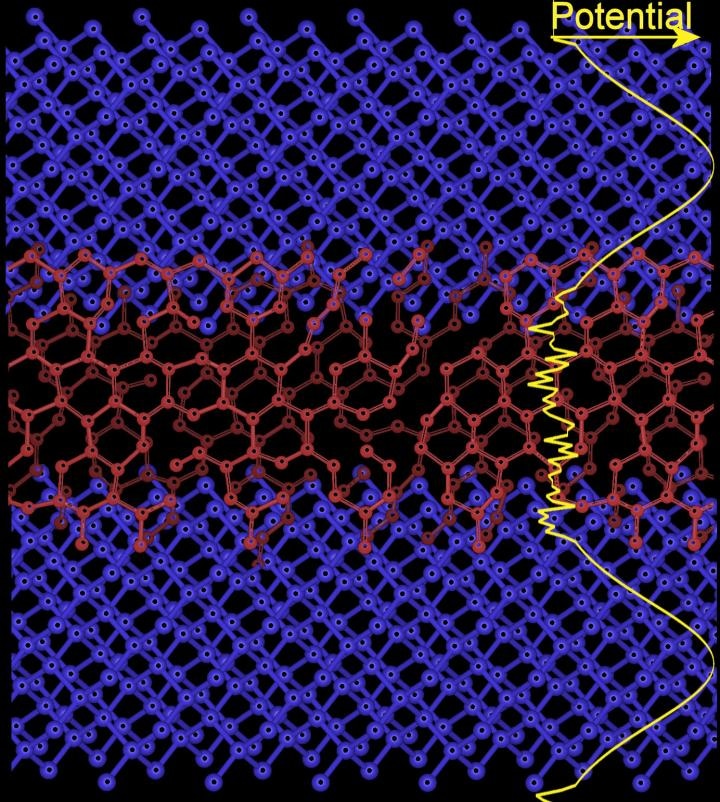Oct 20 2016
 A schematic atomic diagram of a quantum well made from amorphous carbon layers. The blue atoms represent amorphous carbon with a high percentage of diamond-like carbon. The maroon atoms represent amorphous carbon which is graphite-like. The diamond-like regions have a high potential (diamond is insulating) while the graphite-like regions are more metallic. This creates a quantum well as electrons are confined within the graphite-like region due to the relatively high potential in the diamond-like regions. Superlattices are made up of a series of quantum wells. Credit: Wits University
A schematic atomic diagram of a quantum well made from amorphous carbon layers. The blue atoms represent amorphous carbon with a high percentage of diamond-like carbon. The maroon atoms represent amorphous carbon which is graphite-like. The diamond-like regions have a high potential (diamond is insulating) while the graphite-like regions are more metallic. This creates a quantum well as electrons are confined within the graphite-like region due to the relatively high potential in the diamond-like regions. Superlattices are made up of a series of quantum wells. Credit: Wits University
A method to improve carbon superlattices for quantum electronic device applications has been discovered by researchers at the Nanoscale Transport Physics Laboratory from the School of Physics at the University of the Witwatersrand.
Superlattices are developed from alternating layers of extremely thin semiconductors that are only a few nanometers thick. Due to the extreme thinness of these layers, the physics of these devices are monitored by quantum mechanics where electrons act like waves. Exploring the quantum properties of superlattices guarantees the development of new technologies, highlighting a shift from standard electronic devices.
For the past 10 years, the team led by Professor Somnath Bhattacharyya have been working on producing carbon-based nano-electronic devices.
Carbon is the future in the electronics field and it soon will be challenging many other semiconductors, including silicon.
Professor Somnath Bhattacharyya, University of Witwatersrand
The physics of carbon superlattices is considered to be more complex when compared to that of crystalline superlattices, such as gallium arsenide, as the material is amorphous and carbon atoms are likely to create networks and chains.
The Wits group collaborated with researchers at the University of Surrey in the UK to develop an in depth theoretical approach to understand the experimental data attained from carbon devices. Recently, the paper was featured in Scientific Reports (Nature Publishing Group).
This work provides an understanding of the fundamental quantum properties of carbon superlattices, which we can now use to design quantum devices for specific applications. Our work provides strong impetus for future studies of the high-frequency electronic and optoelectronic properties of carbon superlattices.
Ross McIntosh, PhD Student, University of Witwatersrand
In the paper, the team spoke about one of the initial theoretical models that can describe the basic electronic transport properties observed in disordered carbon superlattices.
Almost 10 years ago, Bhattacharyya began his research on the use of carbon for semiconductor applications. This work initially started when he joined Wits University and worked together with co-authors from the University of Surrey to develop and illustrate negative differential resistance and outstanding high-frequency properties of a quantum device developed from amorphous carbon layers. This research was featured in Nature Materials in 2006.
McIntosh accepted the opportunity at honors level in order to measure the electrical characteristics of carbon superlattice devices. McIntosh, now a PhD student holding the experience of working with theoretician Dr. Mikhail V. Katkov, has extended the theoretical framework and produced a method for calculating the transport characteristics of these devices.
Bhattacharyya also hopes that this work will play a significant role in developing carbon-based high-frequency devices.
It will open not only fundamental studies in Carbon materials, but it will also have industrial applications in the electronic and optoelectronic device sector.
Professor Somnath Bhattacharyya, University of Witwatersrand
Currently, superlattices are used as modern high-frequency amplifiers and oscillators, and are also finding new applications in optoelectronics as detectors and emitters in the terahertz regime. Despite the fact that the high frequency optoelectronic and electrical properties of standard semiconductors are limited by the dopants, which help alter their electronic properties, the properties of superlattices can be modified to develop devices that have the potential to work in regimes where standard devices cannot.
Superlattice electronic devices are capable of working at higher frequencies and optoelectronic devices can work at frequencies lower than their standard counterparts. The shortage of terahertz detectors and emitters has resulted in a gap in that specific region of the electromagnetic spectrum, called the terahertz gap, which is a crucial limitation, due to active presence of several biological molecules in this regime. This also places limitations on terahertz radio astronomy.
The extremely strong amorphous carbon devices can work at high voltages and can also be developed in several laboratories spread all over the world, without sophisticated nanofabrication facilities. New carbon-based devices can be used in space technology, biology, new microwave detectors, and science infrastructure such as the Square Kilometre Array (SKA) telescope in South Africa.
“What was lacking earlier was an understanding of device modelling. If we have a model, we can improve the device quality, and that is what we now have,” says Bhattacharyya.